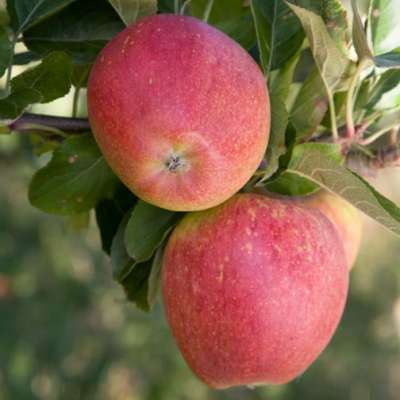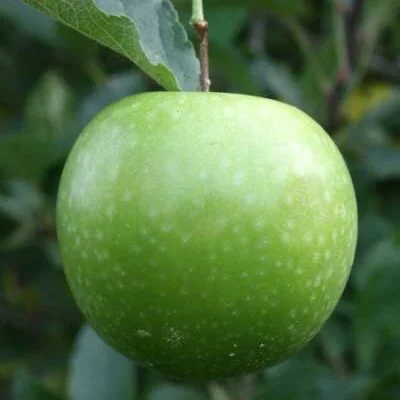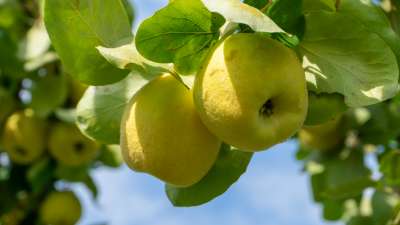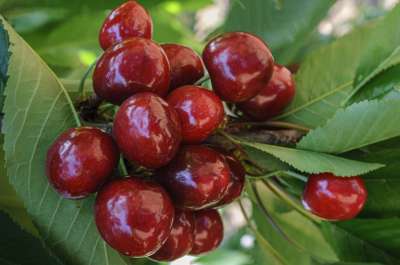Your basket is currently empty!
By far the most popular way of growing fruit trees these days is with dwarf trees for small gardens and it might surprise you that it isn’t just gardeners tucked for space that are turning to compact, smaller trees– commercial growers and larger orchard plantations are choosing compact rootstock trees as a preferred choice rather than a necessity. Dwarf stock fruit trees are simply easier to manage, easier to look after and easier to harvest than bigger trees. Chris Bowers remains your dwarftree nursery of choice for the widest range of small growing fruit trees for patio and small garden.
Dwarf and miniature fruit trees for sale
Why, you might ask, would a large-scale grower with acres to play with want smaller, less productive trees? Because smaller doesn’t necessarily mean less productive – certainly when the weight of crop if calculated per hectare, actually give more back than big, vigorous trees because they enable a closer planting distance. Add into the discussion the fact that the fruits of these smaller trees can often be larger, and of better quality, plus the ease of harvest [no ladders required] as well as general upkeep and it quickly becomes a no-brainer. Oh, and dwarfing trees are also quicker to come into fruit! The less experienced would – quite naturally assume – that a vigorously growing tree will start to yield more quickly than a slower, dwarf one. The reverse is true! Because larger rootstock trees do just that in the early stages – they grow a lot, but don’t necessarily think about actually bearing fruit for 3-4 years, or sometimes more.
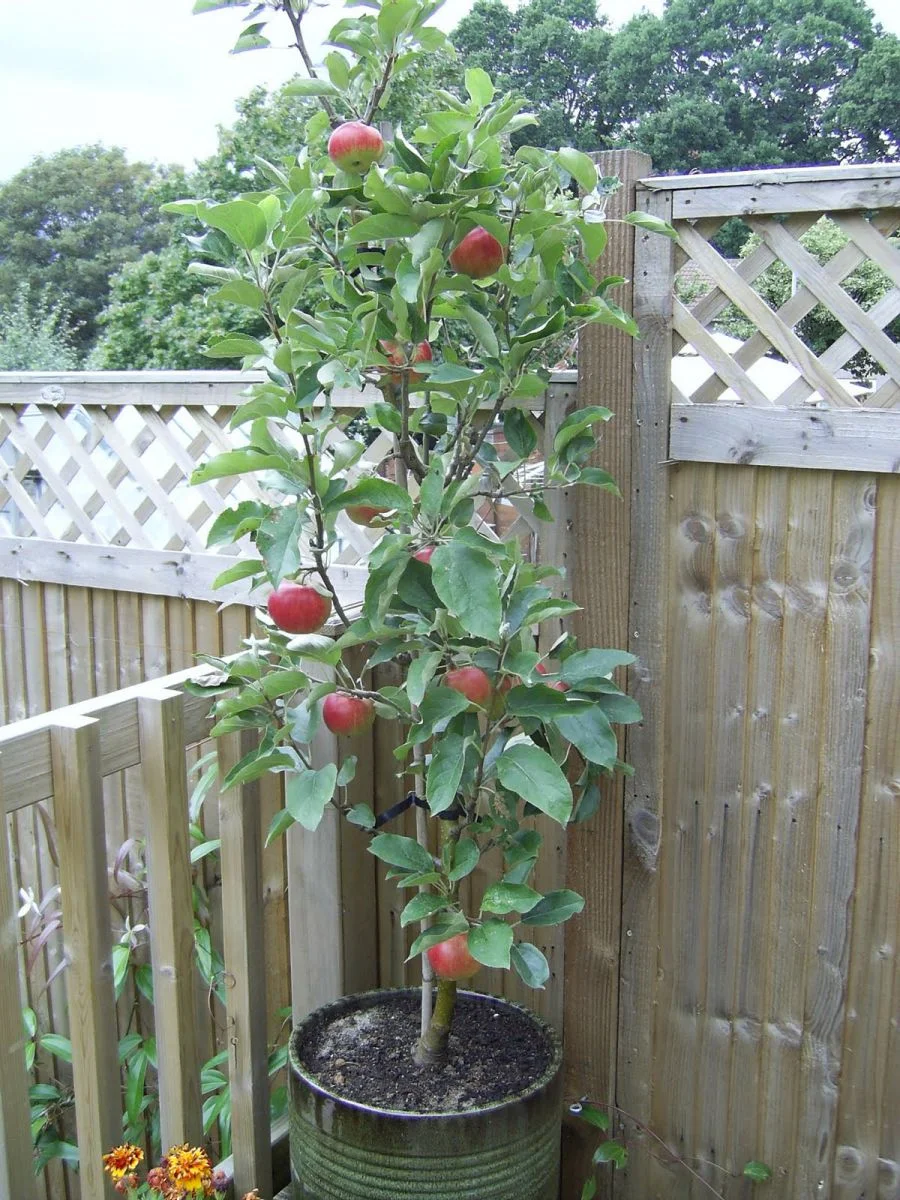
Which isn’t to say I don’t have an admiration for big fruit trees and undeniably they have their uses in the appropriate setting. Particularly if you want to mow or grass beneath them, for example. But, by and large it’s the smaller rootstock trees that fit into todays modern world and modern gardens. They’re simply easier to grow and look after, and quicker too.
I keep talking about rootstocks, don’t I – maybe you don’t really know what a rootstock is. Well, all fruit trees have to be grafted onto a root system that isn’t their own. So you might want to buy a Cox’s Orange Pippin apple tree, or a juicy Victoria plum & that’s just what you will get. The top part anyway – with the branches and trunk – will be that variety. But the roots actually won’t, they belong to an entirely different tree which nurseryman have called a rootstock. The two have been ingeniously joined together as part of the propagation process.
So why do we use rootstocks? Initially it was because the ‘take’ was much better, if you’ve ever tried to root a fruit tree from a cutting you’ll know what a thankless task it is. Even under specialist propagation conditions with mist and cover etc, you would be lucky to get a respectable take, which obviously for commercial reasons on the nursery is of prime importance. By grafting and budding onto rootstocks it was discovered that, once you know what you’re doing [it’s a complex task] you can get 90% or more take under good conditions.
But, even more importantly, rootstocks are used because they influence the tree itself in good ways. A tree that is grafted will crop more quickly, and because rootstocks have been developed with different growing characteristics, it will also determine the size of that tree – and that’s what’s important here. By choosing your trees on dwarfing stocks you can be sure you will have a tree in your garden that won’t outgrow it’s welcome and will crop quickly and reliably.
Your local garden centre probably won’t have much of a choice of rootstocks at all, and may well not have trees on dwarf stock. But by purchasing from specialist fruit tree nurseries you will be presented with a choice of rootstocks, amongst which will be those precious smaller growing ones.
So, what can we grow in this way? More or less anything! With the commercial importance of small-growing fruit trees has come the development of dwarf and miniature rootstocks for apple, pear, plum, gage, damson and cherry.
Choosing the Best Aspect
Fruit trees love sunshine and this is true for the smaller growing miniature and patio fruits as well. The more hours of sun you can give then the better the results will be – you will find the fruit is sweeter and ripens with more colour; remember that it will probably be earlier ins eason too – protected patio’s may have a microclimate that is warmer than the surrounding area.If you have an area that is more shaded then some varieties can still cope and do well – notably the Morello cherry, cooking apple varieties, damson and quince too. Lastly try to select a spot that is out of the wind as there is nothing more irritating than continually having to stand up trees in pots that have blown over!
Dwarf fruit trees for allotments
You will find the recommendations and rootstocks given here work just as well for the allotment, smaller garden, or in patio pots as well. Allotments have height restrictions wherte you aren’t allowed to trees over a certain size, but by making your selection from the information given in this article you can polant with confidence knowing that you will get procutive trees that won’t contravene any rules and regulations.
Patio Fruit Trees for Pots and Containers
These naturally dwarfing trees are ideal for containerisation; just make sure you select the dwarfing trees and an appropriate sized container of not less than 24″. On the nursery we prefer to use a Loam based compost such as John Innes no 2 or a similar type, it’s better than peat based compost for fruit trees in containers. Make sure you feed – and water – regularly and, with a little care your apples, pears, plums, gages, cherries, peaches – and nectarines – can stay in pots for years. In many ways they are easier to care for than garden grown trees because they can more readily be protected from pests, birds and worse weather.
Variety selection
Now comes the exciting bit! You’re done the hard work research bit you [hopefully] know what you are doing now you can daydream about those days harvesting the luscious fruits from your garden which will come around sooner than you think.
No doubt you already have an idea of your preferred choices. But as with everything there arev some good idea’s, and some bad ones! This will guide you through the selection process with a simplified list of the best varieties to go for. In most cases self fertile is best because it avoids the pollination issues associated with other varieties. Plus assuming you don’t have endless space, you may have the room for only one tree so it will need to be self pollinating – trust me.
Patio Apple Trees
Cox’s Orange Pippin remains everyone’s favourite, certainly as far as our customers are concerned it still ranks above foreign imports and more modern less traditional varieties such as Gala and Braeburn. You can grow those two as well, by the way.
Cox’s Orange itself can be problematical; it’s a martyr to diseases so unloess you want to spray a lot to keep things like scab and mildew at bay, it’s probably best avoided. Cox-aholics should go for the Self-fertile Cox’s as it is known – pretty much identical but a bit cleaner. It is also self pollinating [you gathered that from the name didn’t you….]
Red Falstaff is my number one choice of apple tree, period. Why? Because it has everything. It’s super frost hardy, self fertile, reliably heavy cropping and the fruits are of great quality. It’s a bit like a Braeburn to eat, only better I think. It’s ready from early October & will store for several weeks. The blossom is especially attractive too.
If you prefer green crisp apples then Greensleeves is a very good option. Again, self fertile, the inner flesh is so clean, crisp and juicy, refreshing without being too tart. A good doer and easy to grow. It has a sibling which shares all those qualities, it’s called Redsleeves and is earlier to ripen too – you can enjoy Redsleeves from August. It’s sweet and nicely flavoured and also quite cold hardy.
Another one well worth mentioning is ‘Saturn’ which is a newcomer recommended for organic growing because it doesn’t really need spraying to keep diseases at bay. The fruits will keep and have a good flavour. Self pollinating of course.
Popular varieties you may know such as Gala, Braeburn, Golden Delicious, Granny Smith and the cooker Bramleys can all be grown as dwarf trees too; just remember these are all varieties that will require a pollinator with another different variety.
Dwarf Miniature and Patio Pears
I am positive Concorde is by far the best garden Pear tree and it’s also handily quite compact in itself so combine this with a dwarfing rootstock & you have a great little tree for the garden or patio. Concorde is self fertile and has an excellent sweet taste; easy to grow, ripens from late September.
Conference is the luminary everyone knows – it is fine on it’s own and remains a good variety, although Concorde crops more reliably.
Williams Pears are truly delicious and this variety does well as a dwarf tree, but it will need pollinating with a Concorde or Conference.
Patio & Miniature Plum Trees
Plum trees for small gardens are easily grown with some basic knowledge. Make sure youb choose a space saving column tree, or a dwarfing bush roottsock such as Pixy. As for varieties …
Victoria! Everyone cries in unison. It’s understandable, the flavour remains hard to match and in good years the tree branches can get weighted down with the abundance of crop. But it’s a bit hot and cold, you need to accept there will be barren years.
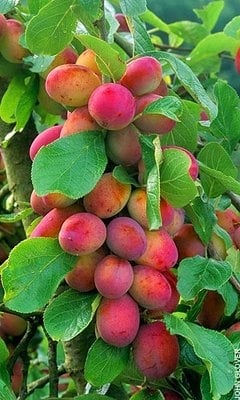
Jubilee would my pick – it comes from Sweden so it seems impervious to cold. Self fertile, crops are pretty impressive and so is the quality. The flavour won’t disappoint and you can eat it from early August. Jubilee suits dessert or cooking.
Czar is an oldie that many folk hold dear. Earlier than Victoria, or Jubilee,l it’s reliably self pollinating and excels at cooking, but you can still eat it fresh once it’s properly ripe. Czar is hardy & productive.
Violetta is another newie worth mentioning. A beautiful oval purple plum with a succulent golden flesh, it’s one to consider. It fruits quite early, from late July and is super-hardy.
Patio Dwarf Cherry Trees
There is a fine range of self fertile near-black to dark red super sweet dessert Cherries. Sunburst, Summer Sun, Celeste and the older Stella all fit the bill admirably. You might want to consider a cooking Cherry ‘Morello Cherry Tree’ – this is a hardy doer & one of the few fruit trees that can take some shade or a cooler position so well worth considering.
Dwarf Patio Peaches, Nectarine & Apricot
You need to make sure the variety you have chosen is naturally dwarf because there aren’t really any dwarfing rootstocks for these fruits. As far as Peaches go, Garden Lady & Bonanza make lovely little trees of scarcely 4-5’ in height. Nectarella is the Nectarine equivalent. Apricot ‘Isabelle’ is my pick for a dwarf apricot. All these fruits are most attractive and a joy to grow, crops can be quite heavy in a sunny sheltered corner. And they are all self fertile so no pollination issues to worry about.
Peach, Apricot & Nectarine are frost hardy to an extent; think about providing some cover or protection if you live in the North or are going through a particularly harsh winter spell, otherwise they should be fine. You can also grow them in a Greenhouse if preferred.Stick to these varieties and you won’t go far wrong, even if you’re a complete beginner.
A mini Apricot tree is harder to find as Apricots aren’t compatible on dwarfing stocks, however there are a couple of naturally smaller growing varieties that can easily be accomodated on the patio, in a container or smaller garden border. Look for Isabelle Apricot Tree and the new Aprigold, both will give delicious results!
Growing in Containers
Of course the obvious gome to your dwarf fruit trees is in an easy to manage container or pot. Observe a few pointers and your trees will thrive in such an environment.
First, the minimum size is a good 24” or so. Fill it with a loam based potting compost such as John Innes no 2 or a similar brand your local stockist can recommend. Never use garden soil. Peat based compost is ok but tends to lose it’s ‘body’ sooner than loam based. I haven’t found any peat substitute composts that work well with trees in containers, it has to be said. But experiment if you want to.
Any type of container is suitable, plastic, clay, whatever. As long asa it has adequate drainage -0 no tree likes to sit in water.
WATERING is the number one essential; every day during the growing season unless it has really, really rained – and you will soon learn that it needs to rain A LOT to do any good when it comes to trees in pots because ‘ordinary’ rain may not penetrate the compost, or it gets shielded by the umbrella of leaf and branches above. So try to get into a routine and water once a day – early or late are the best times. Puddle the compost direct with the watering can or hose.
FEEDING Needn’t be a chore; you can use a foliar feed if you want to but this will need applying every fortnight or so. By far the easiest method, and the one we use on the Nursery, is to apply osmocote granules once every Spring. This type of fertilizer is slow release so you get a steady trickle of nutrients right through the season. Clever, eh!
Pruning Dwarf Plum, Cherry Apple Patio Fruit Trees
This can often be made a quite complicated and convoluted subject; undoubtedly some pruning will be essential to your trees but as long as some basics are observed then it will provide you with good results. There is a lot more information that the less experienced can safely leave to the specialists. When you get the tree it will likely have one straight ‘leader’ branch at the top, or it nay have two or three. One or all of these should be shortened after planting, by about one third of their current length. This will encourage greater bushiness and bud bearing spurs.
Any lower branches that you don’t want can be removed until you have a ‘trunk clearance’ of the desired length. You don’t have to remove lower branches but mostly it results in a more shapely tree and it’s easier to weed beneath, plus these lower laterals don’t tend to be great fruit producers anyway. Cut them off clean at the trunk.
In subsequent seasons more strong growing upright branches will likely be produced. Again, they can and should be cut back by one third.
All pruning is best carried out over winter.
These are the basics that will get you by and help the tree to produce fruits early in life.
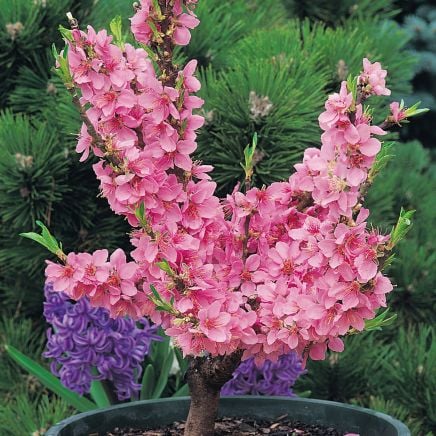
Dwarf Fruit Tree Collection
If you are looking for a nice selection of trees to start growing, for your patio, or for a smaller garden then you will be pleased to know that you can get a nice ready made selection of 1 apple, 1 pear and 1 plum tree, separately labelled. and as self-fertile varieties that will crop well without the need to consider pollination issues. The trees are supplied as 18mont old to two year old specimens; you should get aharvest maybe within 1 year, or 2 years at most. Have a look at this lovely dwarf furit collection by clicking here.



